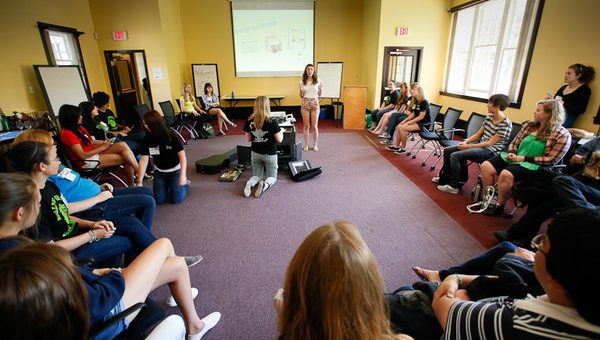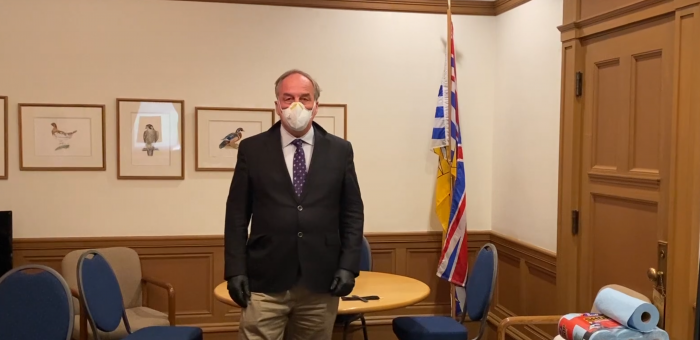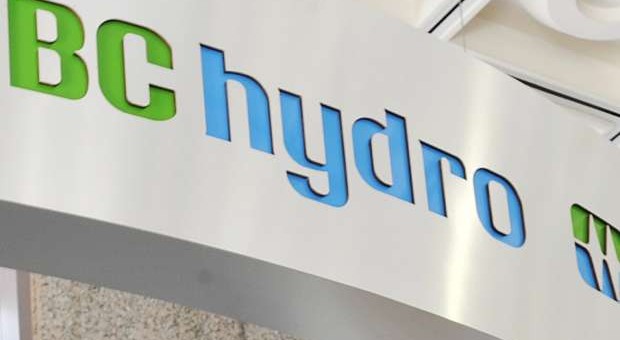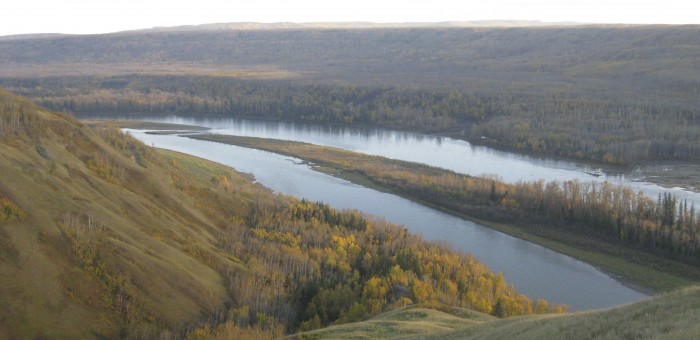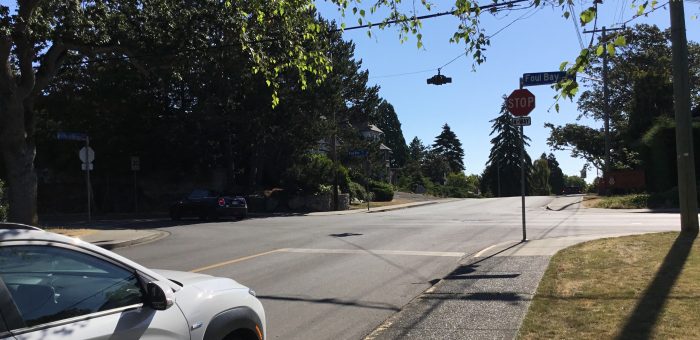Issues & Community Blog - Andrew Weaver: A Climate for Hope - Page 4
Celebrating youth in our community – Anna Friesen
This is the twenty-sixth installment in our series on exceptional youth where we celebrate the outstanding achievements of youth in the Oak Bay-Gordon Head riding. As we commence this chapter in our series we have chosen to celebrate the accomplishments of two sisters in Oak Bay, Anna and Olivia Friesen. These inspirational young adults are enriching our lives with their passion and commitment to the betterment of society.
Anna Friesen
 Normally, my office and I prefer to chat with the youth we’re celebrating in person, but given the circumstances, we elected to conduct our conversation with the two sisters via Zoom. When we spoke to them in early August, they were vacationing at their family cabin in the Okanagan with their parents and family friends – one of whom is Logan Graham a young man we have recognized in the past (link to blog post on Logan to be added here).
Normally, my office and I prefer to chat with the youth we’re celebrating in person, but given the circumstances, we elected to conduct our conversation with the two sisters via Zoom. When we spoke to them in early August, they were vacationing at their family cabin in the Okanagan with their parents and family friends – one of whom is Logan Graham a young man we have recognized in the past (link to blog post on Logan to be added here).
 Originally from the Okanagan, Anna moved to Victoria in early childhood and attended Willows Elementary School and Monterey Middle School. Now entering her final year of high school at Oak Bay Secondary, Anna is one of the rare individuals with the natural talent and work ethic required to find success in multiple areas.
Originally from the Okanagan, Anna moved to Victoria in early childhood and attended Willows Elementary School and Monterey Middle School. Now entering her final year of high school at Oak Bay Secondary, Anna is one of the rare individuals with the natural talent and work ethic required to find success in multiple areas.
Throughout high school, Anna has consistently demonstrated that she is one of the top students in her grade. In grade 10, she obtained a remarkable 97% average with marks of 100% in math, social studies, and entrepreneurship. This past year, Anna somehow managed best her outstanding grade 10 performance by increasing her average to 98%. In grade 12 she will be taking a full load of math and science courses, including the calculus-math 12 combo, physics, biology, and chemistry. And she’s looking forward to the start of the new school year after spending the summer working in the Kiwanis Willows Tea room.
 Outside of the classroom, Anna is a gifted athlete who has performed at a high level in soccer, track, and volleyball. Winner of Oak Bay Secondary’s prestigious Female Athlete of the Year Award in 2019 – a trophy won by former Olympians – she was also the track team’s 2018 Rookie of the Year and won Most Outstanding Junior Track Athlete in 2019. And while she is clearly no slouch in the talent department, she is also a natural leader who is highly regarded by her teammates and coaches, evidenced by her role as captain of her Bays United soccer team.
Outside of the classroom, Anna is a gifted athlete who has performed at a high level in soccer, track, and volleyball. Winner of Oak Bay Secondary’s prestigious Female Athlete of the Year Award in 2019 – a trophy won by former Olympians – she was also the track team’s 2018 Rookie of the Year and won Most Outstanding Junior Track Athlete in 2019. And while she is clearly no slouch in the talent department, she is also a natural leader who is highly regarded by her teammates and coaches, evidenced by her role as captain of her Bays United soccer team.
 Although athletics and academics are big parts of Anna’s life, it quickly became apparent in our Zoom conversation with her that she is also passionate about music and fine arts. She is a dedicated member of the Jazz Band in which she plays the tenor saxophone and has taken visual arts and journalism as electives.
Although athletics and academics are big parts of Anna’s life, it quickly became apparent in our Zoom conversation with her that she is also passionate about music and fine arts. She is a dedicated member of the Jazz Band in which she plays the tenor saxophone and has taken visual arts and journalism as electives.
Despite being so busy with her pursuits in the classroom, athletics, and fine arts Anna has also found time to give back to the community. For the last year, she has been involved with Live Different Oak Bay, a group of students that would have travelled to travel down to rural Mexico to build two homes for disadvantaged families during spring break if not for the COVID-19 pandemic. Alongside the other Live Different members, Anna spent over one year volunteering in the Great Victoria community and helping to fundraise for the trip. In addition to Live Different, Anna has volunteered for Oak Bay’s Cops for Cancer campaign, served as a Mustard Seed Christmas Gift wrapper, and has spent time as a youth soccer coach.

 Although Anna is quick to point out that there are many teachers who have had a positive influence on her during her time at Oak Bay, she particularly enjoyed taking history with Scott Alexander because of his interest in encouraging in class discussions about the course material and current events. Outside of school, Anna cites her parents and the Graham family as positive influences and role models in her life.
Although Anna is quick to point out that there are many teachers who have had a positive influence on her during her time at Oak Bay, she particularly enjoyed taking history with Scott Alexander because of his interest in encouraging in class discussions about the course material and current events. Outside of school, Anna cites her parents and the Graham family as positive influences and role models in her life.
With university fast approaching, Anna is looking to enter a discipline which combines her interests in science and fine arts such as architecture. Based on her strong track record of success so far, we have no doubt that Anna will excel in whatever program she ultimately chooses and look forward to hearing about her future accomplishments.
On the use of face masks to mitigate the spread of COVID-19
Today in the Legislature I rose during Members’ Statements to speak for two minutes about the scientific literature clearly demonstrating the efficacy of using face masks to stop the spread of COVID-19.
Following that I asked the Minister of Health if his government has any intention to implement a law or public health order making masks mandatory in all indoor and crowded spaces, outside of people’s homes, and if not, why not? I further asked the Minister if government does so choose to take this public mandate to require masks, how do they plan to implement and enforce said rules in the province of British Columbia?
Below I reproduce the video and text of both my Members’ Statement and Question Period exchange.
To demonstrate how easy it is to make a mask that has the potential to stop >95% of aerosol born virus transmission, I shot a quick video with how-to instructions below.
Video of Statement
Video of Question Period Exchange
Text of Statement
A. Weaver: I rise today to speak about some of the evidence concerning the efficacy of face masks as a mechanism to reduce the spread of COVID-19. Since the start of the COVID-19 pandemic, numerous studies have been conducted on the subject, and from this research, considerable evidence has emerged that mandating the use of masks in all indoor and crowded spaces outside people’s homes is a low-cost, high-reward measure that policy-makers could and should be pursuing.
To begin with, even though it is difficult to prove causation, we know that almost every nation that has seen widespread usage of face masks has fared better at limiting the spread of COVID-19 than those that haven’t. In many ways, this shouldn’t be surprising. Research conducted well before the current pandemic began — published in 2009 by Ben Cowling and others in the Annals of Internal Medicine — found that the combination of masks and hand hygiene significantly helped reduced the spread of influenza within households.
More recently a March 2020 study, published in the Journal of Medical Virology, showed that homemade masks made of simple four-layer kitchen paper and one layer of cloth can stop the transmission of more than 95 percent of the virus contained within aerosols.
Research directed by Cristopher Leffler from Virginia Commonwealth University — which is, admittedly, still undergoing peer review — has found that “social norms and government policies supporting the wearing of masks by the public as well as international travel controls are independently associated with lower per capita mortality from COVID-19.”
A comprehensive modelling study led by researchers at the University of Cambridge, in the U.K., published in the prestigious Proceedings of the Royal Society A, in June, concluded masks help to dramatically slow the transmission of the virus.
When taken together, mounting evidence is accumulating that the universal use of face masks is one of the most effective tools we have at our disposal to prevent the spread of novel coronavirus. While we await the holy grail of COVID-19 vaccine, it appears that making masks mandatory in all indoor and crowded spaces outside people’s homes can only aid British Columbia’s ongoing pandemic response.
To quote from the summary of the Proceedings of the Royal Society article: “My mask protects you. Your mask protects me.”
Question
A. Weaver: Well, thank you, hon. Speaker. I must say I’ve been here seven years, almost eight years, and this has set a new record. We’ve just finished three questions, and there are only four minutes left in question period. I’m not so sure this is the way this place is suppose to function, and I’m a little disappointed in my colleagues for taking that up and shoving me to the last couple of minutes of question period here. It’s unfortunate. The answers were not targeted, and the questions were rambling, in my view.
Anyway, as more and more evidence about the role that masks can play in reducing the spread of COVID-19 has emerged, growing numbers of jurisdictions have adopted laws making face masks mandatory in all scenarios where it will be difficult for people to remain physically distant. Just last week France introduced measures mandating masks in all enclosed public spaces. Across the pond, the U.K. began implementing a law that makes masks mandatory in grocery stores, shopping malls, post offices, banks and other busy establishments. Here in Canada, Quebec has made masks mandatory in indoor public spaces, while Toronto has established similar rules. And masks will be mandatory in indoor spaces in Nova Scotia, starting this Friday.
A recent poll from Angus Reid has found that there is broad provincial support for rules that would make masks mandatory in public spaces, with over 70 percent of British Columbians in favour of the changes. And although not all members of the public would be able to adhere to these rules, due to underlying physical or mental health conditions, the vast majority of the public would be able to follow them with relatively few personal costs.
My question is to the Minister of Health. Given the evidence in favour of universal wearing of masks and the broad public support for such a measure, will this government implement a law or public health order that makes masks mandatory in all indoor and crowded spaces, outside of people’s homes, and if not, why not?
Answer
Hon. A. Dix: I want to start by expressing my appreciation to the member for Oak Bay–Gordon Head for his consistent and thoughtful support for public health measures during this pandemic. It is much appreciated, and I thank him for his questions. He will know that Dr. Henry has answered this specific question a number of times in the past few weeks. Let’s see how I do, hon. Speaker.
You’ll know that, in July, we understand right now quite a bit about community transmission of COVID-19. That’s why we’ve taken specific public health measures — for example, public health measures to deal with houseboats, to deal with temporary accommodations, to deal with rental accommodations and resorts, to deal indeed with bars and with nightclubs and even with strip joints, and specific steps to deal with what is a significant issue in the agricultural industry.
Dr. Henry doesn’t believe, and I don’t believe at this time, that community transmission in B.C. justifies a mandatory mask mandate — not at this time. We think that it would not be justified in light of the significant challenges in both putting it into place and the very significant exemptions, which I know the member would understand, that would be required to do so.
He also knows — I know we have a little bit of time, he and I, for these questions, so I’ll just give him a little bit more information — that masks are, well, very important in terms of the hierarchy of measures we can take. It’s less effective than physical distancing and barriers and administrative measures. That said, Dr. Henry recommends, and I recommend, wearing a non-medical mask in circumstances where physical distancing cannot be maintained. I wear a mask in stores. I wear a mask in grocery stores. I wear a mask on public transit. I think, in these times, in particular in these times, wearing a mask is a reflection of good COVID sense but also a reflection of community respect. Many businesses, in fact, which have small spaces, are mandating masks within their businesses, within their COVID-19 plan.
I want to assure the member that this is our view for the moment, that we consistently have adapted based on the evidence, and we will continue to do so. The efforts of Dr. Henry, of public health, of the government and, indeed, of all the people of B.C. will continue to be founded on evidence and on science, and I know he appreciates that fact.
Supplementary Question
A. Weaver: I do note that the member opposite said my question was one minute and 30 seconds long. I just will say that, indeed, it was, and that we should have been able to have 20 such questions in this period, but we’re not getting to it.
I’d like to thank the minister for his response. I do appreciate government’s reservations about imposing a law that would make masks compulsory, and government should be commended for the job done so far in limiting the spread of COVID-19. But lurking in the background of discussions about masks and COVID-19 are concerns around the potential for government overreach. I understand that there’s a slow pace. However, we’re sitting in a once-in-a-century pandemic. Measures will need to be taken that will temporarily restrict some of our normal freedoms in order to preserve our collective safety.
One study, for example, that I referred to earlier in statements today, shows that even with a 50 percent efficiency, instead of a 95 percent type efficiency of most masks, you still get a lower R-rate number than you would without wearing masks. Since enforcing regulations around mandatory masks is frankly impossible for any government to handle by itself, many jurisdictions have appealed to the private sector to help with these rules, like in Quebec, for example, where periodic inspections happen in place, and in instances where individuals or businesses are caught, authorities have typically been empowered to apply fines.
My question is once more to the Minister of Health. If the government does so choose to take this public mandate to require masks, how do they plan to implement and enforce said rules in the province of British Columbia?
Answer
Hon. A. Dix: As noted, and this is the strong view of public health, with Dr. Henry, and it’s my strong view, at the moment, a mandatory mandate for masks is not required, is not desirable in British Columbia for some of the reasons that we have discussed at length and I’m happy to continue to discuss, because I think it’s an issue of public interest and debate. I applaud people who take the steps, because I think it’s an act of respect to wear non-medical masks, especially in areas where physical distancing can’t be maintained. That is of vital importance, and it is part of our collective response to COVID-19.
What we’re going to continue to do in B.C. is follow the science and follow the evidence in our pandemic. Yes, what happens in Quebec and what happens in France and what happens in Alberta is important, but one of the reasons we have been successful in B.C. is a determination also to follow our own B.C. course to deal with our own B.C. pandemic. That led to our response and our single-site order in long-term care. It led to our action, different from other jurisdictions, in dealing with temporary foreign workers in agriculture. I think these sorts of steps, which demonstrate a commitment to public health and to breaking the chains of transmission have been what have made us successful.
But I want to say this. I appreciate the comments of the hon. member, and I want to take this opportunity to thank all of the members of the House, as people have consistently made positive suggestions, been supportive.
This has been our response, our collective response to the COVID-19 pandemic, and it has been successful so far, I think, with extraordinary challenges and with some considerable losses. But we need to continue to do this together. There are weeks and months and maybe years to come. That will require generosity and positive spirit
Draft Segment 014
response to the COVID-19 pandemic, and it has been successful so far, I think, with extraordinary challenges and with some considerable losses.
We need to continue to do this together. There are weeks and months and maybe years to come, and that will require generosity and positive spirit together to continue to do that. So I encourage people to make suggestions, to engage in public debate on these issues, but mostly to be respectful of one another and for all of us to take our responsibility, as the government is, as we as a Legislature are, in breaking the chains of transmission of COVID-19 in B.C.
Unfortunately BC Greens force baby to get thrown out with bathwater on Clean Energy Bill
Last week I wrote about BC NDP’s Bill 17: Clean Energy Amendment Act, 2020 that proposed amendments to the Clean Energy Act allowing BC Hydro to:
- Implement a 100% clean energy standard;
- Remove BC Hydro’s self-sufficiency provision. That is BC Hydro is currently required to hold the rights to enough electricity from generating facilities solely within the province to meet its projected energy demand (more on this below).
- Remove Burrard Thermal from the list of heritage assets which would allow BC Hydro to dispose of, or develop, this asset.
In my blog post entitled Bill 17, Burrard Thermal, BC Hydro self sufficiency and clean electricity, I detailed a series of amendments that ensured:
- BC can still implement a 100% clean energy standard;
- Burrard Thermal will be removed from the list of BC Hydro’s heritage assets;
- BC Hydro’s self sufficiency requirement for average water conditions at their legacy hydro electric dams is retained;
- The definition of clean electricity reverts back to the original Clean Energy Act.
That blog post, together with my exchange during Question Period with the Minister of Energy Mines and Petroleum Resources on July 15th, provides a comprehensive analysis of why I proposed the amendments. I conclude the post with this:
I have communicated my intention of supporting the bill at second reading to both the BC NDP and the BC Liberals. If the bill fails at second reading, I won’t get a chance to introduce my amendments during committee stage and I fear that its positive aspects will be lost. That is, the preverbial baby will be thrown out with the backwater. The onus is ultimately on my former colleagues in the BC Green Party to indicate whether or not they support the Bill as it stands, or the amended Bill as I have proposed. Under the “good faith and no surprises clause” of the Confidence and Supply Agreement Premier Horgan and I signed in 2017, the BC Greens will have to communicate their intentions to government prior to the bill being called for debate.
In an odd press release and through an an even more odd, and unsupportable amendment, the BC Greens made it clear that this Bill will die on the order papers. And this troubles me.
The press release appears to be tone deaf. The feedback my office received from Indigenous communities has been almost exclusively on the government’s proposed removal of the self sufficiency clause (see my blog and also my Question Period exchange for more details). Yet the BC Greens propose no amendments in this regard and instead make the bizarre claim that more consultation is needed. The BC Greens could have either proposed to support my amendments to remove the self sufficiency clause, which has been sitting on the order papers since July 14, or introduced similar amendments themselves. This would ensure that the very positive aspects of Bill 17 are passed in a timely fashion. They chose not to, thereby ensuring Bill 17 will die on the order papers.
Unfortunately, the BC Greens’ proposed amendment is unsupportable and in my view shows a lack of understanding of the complexities of the energy file. I too heard feedback from stakeholders that the definition of clean electricity was problematic. However, many of the people raising this issue didn’t realize that the existing Clean Energy Act has very similar regulation enabling legislation. My amendments ensured that the existing definition remained in place for clarity.
Below I reproduce all definitions so I can expand upon this:
The various definitions
1) Existing definition in Clean Energy Act:
“clean or renewable resource” means biomass, biogas, geothermal heat, hydro, solar, ocean, wind or any other prescribed resource;
[there is no definition of clean electricity]
2) BC NDP government proposed change:
“clean electricity” means electricity
(a) generated from a clean resource, or
(b) deemed under the regulations to be clean electricity;
“clean resource” means a prescribed resource;
3) My proposed amendment to government’s change:
“clean electricity” means electricity generated from a clean or renewable resource;
(a) generated from a clean resource, or
(b) deemed under the regulations to be clean electricity;
“clean resource” means a prescribed resource;
4) BC Green proposed amendment to government’s change:
“clean electricity” means electricity generated from a renewable non-fossilized resource, including biomass, biogas, geothermal heat, hydro, solar, ocean and wind;
(a) generated from a clean resource, or
(b) deemed under the regulations to be clean electricity;
“clean resource” means a prescribed resource;
You’ll see that the government proposed to essentially leave the definition of “clean electricity” up to regulation. My amendments simply reverted the definition to what has been in place in the existing Act for more than a decade.
The BC Greens basically took the existing definition in the Clean Energy Act and added “non fossilized resource”. While at first glance this might seem sensible, it is problematic for a number of reasons:
1) “non-fossilized resource” is not defined in the bill.
2) Their definition of “clean electricity” may in fact preclude aspects of the establishment of a hydrogen economy. One of the main ways to generate hydrogen is to use steam-methane reformation and partial oxidation to strip it from methane molecules.
3) Despite the BC Green claim, leaving in: “clean resource” means a prescribed resource means that the definition of clean electricity and clean resources is not in fact stronger. It is, ironically, weaker.
In summary, it appears to me that rather than doing what is right and ensuring that the key aspects of the bill are retained while more work is done on the self sufficiency clause, as I proposed, the BC Greens have chosen to introduce 11th hour politically-motivated amendments as a face-saving exercise.
I am profoundly disappointed in the BC Greens for forcing the baby to be thrown out with the bathwater on Bill 17. As I noted earlier, under the “good faith and no surprises clause” of the Confidence and Supply Agreement Premier Horgan and I signed in 2017, the BC Greens should communicate their intentions to government prior to the bill being called for debate. I’m not sure what the BC Greens were thinking, but I certainly understand why the BC NDP might not choose not to bring this bill forward for debate in light of the uncertainty created by the BC Green position on this file.
Bill 17, Burrard Thermal, BC Hydro self sufficiency & clean electricity
Over the last few days there has been a flurry of emails to MLAs around the province concerning BC NDP’s Bill 17: Clean Energy Amendment Act, 2020. These emails articulate opposition to the removal of BC Hydro’s “self sufficiency clause”.
Let’s take a look at this issue in more detail.
Bill 17 proposes changes to the Clean Energy Act and Utilities Commission Act to give BC Hydro the ability to consider a range of energy resources and asset options as it prepares its Integrated Resource Plan.
The bill has been put together in what teachers reading this will recognize as a “two stars and a wish” format. That is, sandwiched between two very positive changes is one that is creating a great deal of concern.
The bill proposes amendments that will allow BC Hydro to:
- implement a 100% clean energy standard;
- Remove BC Hydro’s self-sufficiency provision. That is BC Hydro is currently required to hold the rights to enough electricity from generating facilities solely within the province to meet its projected energy demand (more on this below).
- Remove Burrard Thermal from the list of heritage assets which would allow BC Hydro to dispose of, or develop, this asset.
You’ll get absolutely no argument from me about the importance of implementing a 100% clean energy standard. The bill does not require 100% of BC’s electricity to be produced from clean sources, but it does set up a reporting structure and the intention is clearly to move in that direction as part of CleanBC, which the BC NDP government and I developed collaboratively in 2018. The requirement for 100% clean electricity would have to be set through regulation (Order in Council) and presumably that would occur after consultation with Washington, Oregon and California as to the precise definition of what is considered “clean electricity”. Presently, about 95% of BC’s electricity is generated from renewables.
You’ll also get absolutely no argument from me about the needs to mothball Burrard Thermal. Burrard Thermal was shut down in 2016 by the previous BC Liberal government after announcing it would do so in 2013. It sits on 78 acres of waterfront property in Port Moody that could be put to better use. What’s particularly strategic about the location is that it already has transmission lines to the area and so could supply power to heavy users of clean electricity. In fact, this strategic asset could be used as a carrot to attract to our province industry looking for access to clean energy as a means of demonstrating corporate leadership and developing green branding. Ever since I got elected in 2013, I have been pointing out that British Columbia should be using its abundant clean electricity resources to attract cleantech and manufacturing industries here. And so I am very supportive of government’s intentions in this regard.
What’s more troubling is the removal of BC Hydro’s self-sufficiency provision. In reality, BC Hydro does not actually have a stringent self-sufficiency clause in place, although we used to. That’s because on February 3, 2013 the BC Liberals relaxed this clause (to protect ratepayers from hydro increases) by changing the requirement for BC Hydro to be self sufficient for average instead of critical (i.e. the most adverse sequence of stream flows occurring within the historical record) water conditions at their legacy hydro electric dams. Back in May 2019, I expanded on BC Hydro’s lack of self sufficiency in a series of questions I asked the Minister of Energy, Mines and Petroleum Resources.
Much like the BC Liberals wanted to protect ratepayers from hydro increases, the BC NDP clearly want to do the same. The removal of the rest of the self sufficiency clause would create electricity trading opportunities with the United States via the highly successful power trading arm of BC Hydro — Powerex. The US is awash with very cheap solar power that Powerex could purchase during the day and at night, when the sun isn’t shining, they could sell back hydro power from our legacy dams at a premium. The arbitrage opportunities are boundless and it is no doubt that this would a) protect ratepayers from hydro rate increases and b) bring in much needed revenue to our province.
But here’s the twist, in doing so, we will likely put the final nail in the coffin for BC’s once vibrant clean energy sector.
When the BC NDP introduced Bill 17: Clean Energy Amendment Act, 2020 on June 23, I immediately determined that it was problematic. The problem was not with the desire for BC Hydro to keep rates low or use our legacy dams like batteries (one of my very first blog posts upon getting elected was on this topic), but rather that some of the unforeseen consequences and missed opportunities had not been fully explored (see for example my question to the Minister of Energy Mines and Petroleum Resources on July 15, 2020). And so I immediately set out to work with the BC Legislative drafters to propose amendments to the Bill (reproduced below). The amendments have been sitting on the order papers since July 14 and will be moved during committee stage for Bill 17.
The amendments ensure that:
- BC can still implement a 100% clean energy standard;
- Burrard Thermal will be removed from the list of BC Hydro’s heritage assets;
- BC Hydro’s self sufficiency requirement for average water conditions at their legacy hydro electric dams is retained;
- The definition of clean electricity reverts back to the original Clean Energy Act.
Should these amendments pass, the positive aspects of Bill 17 will be retained whereas the more troubling components will be removed.
I have communicated my intention of supporting the bill at second reading to both the BC NDP and the BC Liberals. If the bill fails at second reading, I won’t get a chance to introduce my amendments during committee stage and I fear that its positive aspects will be lost. That is, the preverbial baby will be thrown out with the backwater. The onus is ultimately on my former colleagues in the BC Green Party to indicate whether or not they support the Bill as it stands, or the amended Bill as I have proposed. Under the “good faith and no surprises clause” of the Confidence and Supply Agreement Premier Horgan and I signed in 2017, the BC Greens will have to communicate their intentions to government prior to the bill being called for debate.
I look forward to the exciting opportunities for innovation that present themselves with the removal of Burrard Thermal from the list of BC Hydro’s heritage assets and the move of BC to 100% clean electricity.
Proposed Amendments to Bill 17
17 Mr. Weaver to move, in Committee of the Whole on Bill (No. 17) intituled Clean Energy Amendment Act, 2020, to amend as follows:
SECTION 1, by deleting the text shown as struck out and adding the underlined text as shown:
1 Section 1 (1) of the Clean Energy Act, S.B.C. 2010, c. 22, is amended
(a) in the definition of “acquire” by striking out “used in relation to the authority” and substituting “in sections 7, 12 and 15”,
(b) by adding the following definitions:
“clean electricity” means electricity generated from a clean or renewable resource;
(a) generated from a clean resource, or
(b) deemed under the regulations to be clean electricity;
“clean resource” means a prescribed resource;
“compliance period” means a prescribed period; , and
(c) by repealing the-definition of “electricity self sufficiency”, and
(d)(c) by adding the following definitions:
“grid-connected customer” means a person in British Columbia who receives service through a direct or indirect connection to the British Columbia electrical transmission grid, other than a person in the Northern Rockies Regional Municipality;
“regulated person” means
(a) the authority,
(b) a prescribed public utility or class of public utilities, or
(c) a prescribed person or class of persons who deliver electricity to grid-connected customers; .
SECTION 2, by deleting the text shown as struck out and adding the underlined text as shown:
2 Section 2 is amended by adding the following paragraph:
(a) by repealing paragraphs (a) and (n), and
(b) by adding the following paragraph:
(q) to serve grid-connected customers with clean electricity.
SECTION 3, by deleting section 3.
SECTION 4, by deleting section 4.
SECTION 6, by deleting section 6.
SECTION 8, by deleting the text shown as struck out and adding the underlined text as shown:
8 Section 37 is amended by adding the following paragraphs:
(a) by adding the following paragraphs:
(a.1) for the purposes of the definition of “clean electricity” in section 1 (1), deeming electricity delivered under any of the following to be clean electricity:
(i) a specified contract or class of contracts;
(ii) a specified rate or class of rates;
(iii) a specified international agreement;
(a.2) a regulation made under paragraph (a.l) may prescribe that of the electricity delivered, a specified percentage is deemed to be clean electricity;
(a.3) prescribing resources for the purposes of the definition of “clean resource” in section 1 (1);
(a.4)(a.1) prescribing a period for the purposes of the definition of “compliance period” in section 1 (1);
(a.5)(a.2) prescribing public utilities, classes of public utilities, persons and classes of persons for the purposes of the definition of “regulated person” in section 1 (l); ,
(b) in paragraph (c) by striking out “sections 6 and 13” and substituting “section 13”, and
(c) by adding the following paragraphs:
(j) prescribing requirements for the purposes of section 19.1;
(k) prescribing matters that must be addressed in a report prepared under section 19.2 (1);
(l) for the purposes of section 19.2 (2), prescribing requirements respecting the preparation, verification and submission of reports, including, without limitation, the following:
(i) respecting the form and content of reports;
(ii) respecting who may conduct verifications;
(iii) respecting the conduct of verifications;
(iv) requiring reports or statements in relation to verifications, and respecting the form and content of those reports and statements;
(v) respecting the dates by which reports must be submitted to the minister.
SECTION 10, by deleting section 10.
SECTION 11, by adding the underlined text as shown:
11 Sections 44.1 (8) (b), 44.2 (5) (c), 46 (3.1) (c) and 71 (2.1) (c) and (2.5) (c) of the Utilities Commission Act, R.S.B.C. 1996, c. 473, are amended by striking out “sections 6 and 19 of the Clean Energy Act” and substituting “sections 6, 19 and 19.1 of the Clean Energy Act”.
On the potential closure of Richardson Street at Foul Bay Road
Over the last few days my office has received a number of emails concerning the City of Victoria’s proposed closure of Richardson Street at its junction with Foul Bay Road. The stated goal for this closure is to install bike lanes and limit the traffic along Richardson Street to fewer than 500 cars per day. Unfortunately, the City of Victoria has chosen not to send their proposal to the District of Oak Bay for comment. In my view, this is unacceptable since Victoria is surrounded by neighbouring communities and any traffic flow changes have significant concomitant regional consequences. It’s particularly troubling as Foul Bay Road represents the boundary between Oak Bay and Victoria.
Below I reproduce a letter I sent today to Victoria Council expressing my concerns regarding their lack of consultation.
Text of Letter
Dear Mayor and Council of the City of Victoria,
I am writing to you to express my profound concern regarding your proposed forthcoming developments for Richardson Street at the Foul Bay junction. As you will know, the junction where Richardson Street meets Foul Bay resides squarely in the riding of Oak Bay Gordon Head which I represent.
I understand that Council has unilaterally decided that it wishes to restrict traffic to only 500 cars per day along Richardson Road without consulting with the District of Oak Bay. To meet this arbitrary target, council decided to close off Richardson Street at Foul Bay and hence only allow bike traffic through the intersection.
Richardson Road is one of only two main roads that connect south Oak Bay (where a substantial number of civil servants live) and downtown Victoria. While I applaud your efforts to create more biking infrastructure for the City of Victoria, I remind you that Victoria is surrounded by neighbouring communities and any traffic flow changes have significant concomitant regional consequences. In addition, for many people living in south Oak Bay, cycling is not an option. In my view, it is not appropriate for your council to proceed with this project without formally referring this proposal to the District of Oak Bay for comment.
As you will also know, Oak Bay is planning to expand their active transportation infrastructure. They are in the midst of ongoing consultation and planning. It strikes me as both a missed opportunity and inappropriate for you not to consult with them on your plans. My recommendation to government is that provincial funding requests for the Richardson Corridor project not be considered until such time as said consultation is completed.
I am not sure what, if any, regional traffic flow modelling your council has done on the proposed closure of this intersection. Nevertheless, as someone who was born and grew up in Victoria, I would suggest that all that this will do is divert traffic from South Oak Bay to Fairfield Road. This will greatly increase traffic on side streets throughout the area. As you know, Fairfield Road passes two elementary schools: Margaret Jenkins and Sir James Douglas. This substantially increased traffic flow on Fairfield Road presents a very real, increased danger to the elementary school students. In addition, the substantially increased traffic on the side streets also presents a very real, increased danger to children. Fairfield Road also meanders by Ross Bay Cemetery, Fairfield Plaza and Hollywood Park. In many places, it is very narrow and very busy. Richardson Road, on the other hand, could easily handle separated bike lanes.
I recognize that Victoria Council might counter that they expect traffic to come along Oak Bay Avenue instead. I would suggest that this is certainly not a given as Oak Bay Council is presently exploring traffic options in the Oak Bay Village to make it more pedestrian friendly. In essence, this is precisely why consultation with neighbouring communities is imperative.
Thank you in advance for considering this request that you enter into consultation with the District of Oak Bay in advance of proceeding with the closure of Richardson Road at Foul Bay.
Yours sincerely
Andrew Weaver
MLA Oak Bay-Gordon Head
Cc BC Minister of Transportation (minister.transportation@gov.bc.ca)
BC Minister of Environment (env.minister@gov.bc.ca)
BC Minister of Municipal Affairs and Housing (mah.minister@gov.bc.ca)
Oak Bay Mayor and Council (mayor@oakbay.ca, obcouncil@oakbay.ca)

